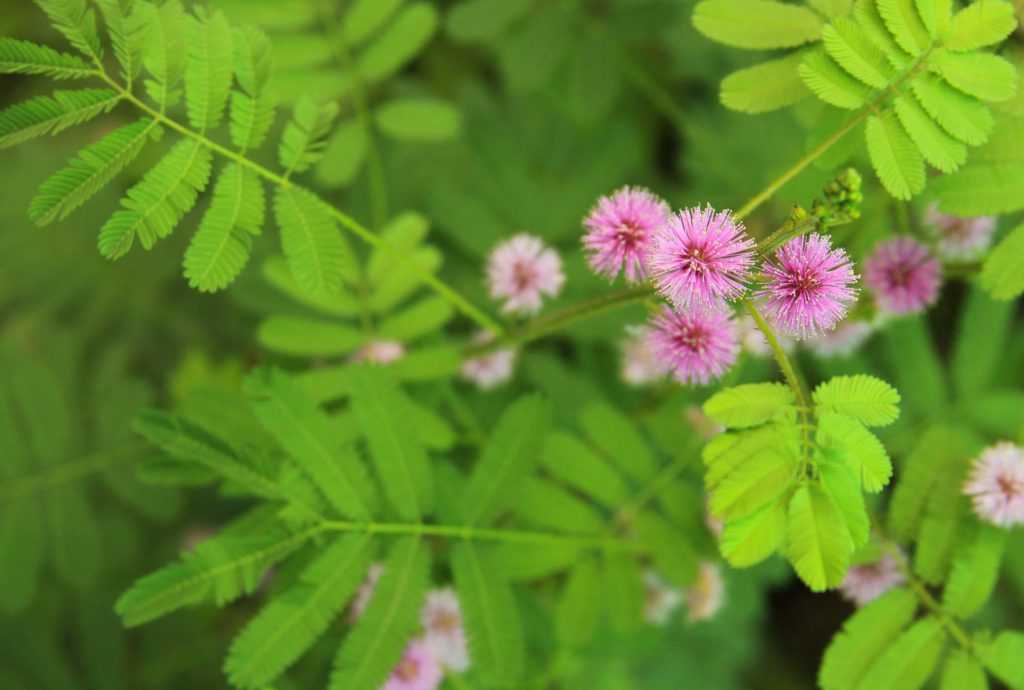Tepezcohuite/jurema tree
(Mimosa hostilis/tenuiflora)
botanical description
Mimosa hostilis/tenuiflora generally measures between 3 and 4 meters in height, and can reach up to 8 meters. It is a thorny, deciduous tree, with a woody trunk, the bark is rough, reddish brown to grayish in color, with a resinous odor and flavor. The thorns on its stems, which are short and very sharp, can reach up to 3 cm long.
Its leaves measure 10 to 25 cm long, are alternate and composed of 3 to 9 pairs with 20 to 40 small, linear and oblong, almost sessile leaflets, and petioles that measure between 1 to 2.5 cm. long.
The flowers are white, sessile, in the form of long, dense spikes of 5 to 8 cm, with a campanulate calyx almost as large as the corolla.
The fruit is produced in the driest time of the year, it has the shape of oblong pods, which measure between 3 to 4 centimeters long and 7 millimeters wide, usually containing between 3 to 4 seeds in each pod.
Its seeds are lenticular and shiny, reddish brown. They measure about 4 millimeters long, 3.2 millimeters wide and 1.5 millimeters high.
Wind and rain facilitate the release of seeds, which due to their texture are light and suitable for being dispersed by the wind. Seedlings emerge and establish preferably in open, light-exposed areas.
The seeds can be viable even after 50 years of storage, thanks to their hard, waterproof seed coat, which is resistant to abrasion and is covered with a layer of shiny wax. Therefore, scarification is necessary to break dormancy and make them viable for germination, whether chemical, by immersion in boiling water, or mechanical.

Tepezcohuite/Jurema harvest
To make a sustainable harvest of Mimosa hostilis/tenuiflora root, only some of the lateral roots should be cut; not the entire tree, so that it can recover. The harvested trees are marked with a sign and allowed to rest for at least two years.
To carry out self-sustainable use of the species, reproduction and reforestation must also be promoted.
Distribution, and habitat of the Tepezcohuite/Jurema
Mimosa hostilis/tenuiflora is a widely distributed species: It is found in Brazil, Venezuela, Colombia, Panama, Honduras, El Salvador, Nicaragua, Guatemala, Belize and Mexico. Especially in semi-arid areas of eastern Brazil.
In Mexico, it is found especially in the region of Chiapas and Oaxaca at altitudes between 800 and 1000 meters above sea level. It needs a warm subhumid climate with an average annual temperature of 18º degrees Celsius.
It lives in deciduous forests, thorny scrub and pine-oak forests, between an altitude of 25 to 1520 meters above sea level.
Elsewhere, Mimosa hostilis/tenuiflora is also known as: Mimosa cabrera, Mimosa nigra and Mimosa limana.

Adaptability
It is a very resistant species, which does not require many nutrients in the soil to thrive and is drought tolerant. It has a wide range of tolerance to the different physicochemical parameters of the soil, to climatic factors, and also a great potential for dispersal and establishment, especially in open areas, exposed to sunlight and with low soil moisture content.
Symbiosis
In the roots of Mimosa hostilis/tenuiflora a symbiotic association occurs with some species of the genus Rhizobium, whose name comes from the Greek rhiza, which means root. In this symbiosis, the plant provides the bacteria with carbon compounds as a source of energy and a protective environment, and in return receives nitrogen in a form usable for the formation of proteins.
Although parasitic varieties of rhizobacteria exist, the term generally refers to bacteria that form a mutually beneficial relationship. Bacteria form colonies on the roots, generating root nodules.
Mimosa hostilis/tenuiflora is a species of the Fabaceae family, and the species of this family increase soil fertility through the fixation of environmental nitrogen that occurs thanks to this symbiotic relationship.
Other uses
Jurema / Tepezcohuite wood is used in Honduras, Guatemala, El Salvador, Nicaragua, Colombia and Venezuela to make a high-calorie charcoal, as well as a species for reforestation.
In Mexico (especially in Oxaca and Chiapas) wood is also used for charcoal, and to build living fences, to demarcate plots of land or animal pens.
The tannins extracted from this species are used in paints and for tanning.
Taxonomy
Kingdom: Plantae
Division: Magnoliophyta
Class: Magnoliopsida (Dicotyledons)
Order: Fabales
Family: Fabaceae
Subfamily: Mimosoideae
Genre: Mimosa
Species: Mimosa tenuiflora (Willd) Poir

Other uses
Jurema / Tepezcohuite wood is used in Honduras, Guatemala, El Salvador, Nicaragua, Colombia and Venezuela to make a high-calorie charcoal, as well as a species for reforestation.
In Mexico (especially in Oxaca and Chiapas) wood is also used for charcoal, and to build living fences, to demarcate plots of land or animal pens.
The tannins extracted from this species are used in paints and for tanning.
Taxonomy
Kingdom: Plantae
Division: Magnoliophyta
Class: Magnoliopsida (Dicotyledons)
Order: Fabales
Family: Fabaceae
Subfamily: Mimosoideae
Genre: Mimosa
Species: Mimosa tenuiflora (Willd) Poir
